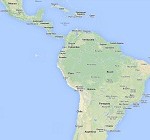Latin America: Elections in 2014
Five countries are going to the polls in 2014:
Panama, on May 4. President Ricardo Martinelli will not be not allowed to stand for a consecutive second term. His wife is being nominated as a vice-presidential candidate. José Domingo Arias will be the possible presidential candidate of the ruling centre-right Democratic Change party.
Colombia, on May 25. President Juan Manuel Santos, leading in the opinion polls, is likely to win a second term.
Brazil, on October 5. President Dilma Rousseff is expected to win her bid for a second term without much difficulty.
Bolivia, on October 5. President Evo Morales could win a third term, since there are no serious contenders to match the popularity of Morales, the first native Indian president in the history of Bolivia.
Uruguay, on October 26. Former President Tabaré Vazquez from the ruling centre-left coalition is the front-runner.
The Left is expected to retain power in Brazil, Uruguay and Bolivia. The Centre-right will keep its hold on Colombia and Panama. Leftist candidates have already won in Chile, Costa Rica and El Salvador, confirming the continuing popularity of leftist politics in Latin America.
Brazil: Oil sector plans
In the last week of February, Petrobras, Brazil’s state-run oil company, announced its investment plan for 2014-18 and vision statement till 2030.
According to the ‘Petrobras 2030 Strategic Plan’ document, the company will invest the huge sum of $220.6 billion in the 2014-18 cycle. Of the total, $112.5 billion will be for production, $18 billion for exploration, $23.4 billion for infrastructure and support, $38.7 billion for downstream activities, and $2.7 billion for biofuels.
Pre-salt offshore fields discovered in recent years will account for the bulk of the exploration and production investment. Petrobras expects to increase its oil production to 4 million barrels per day by 2020, from 2.5 million in 2013.
The overall Brazilian production of crude by 2035 is projected by different agencies at 4.7 to 6.6 million barrels per day, making Brazil one of the six largest oil producers of the world. The Petrobras strategic plan notes that Latin America will produce the highest volume (5.3 million bpd) of crude oil from new discoveries, as compared to other regions of the world. Of this, Brazil alone will account for 2.7 million barrels.
The large investment by Petrobras and other companies in the Brazilian hydrocarbons sector is an opportunity for Indian businesses to get contracts, and export materials and equipment. The Indian export promotion councils and industry chambers should systematically use this opportunity. The government of India and the Eximbank of India can consider extending lines of credit to Indian companies, as China has already done to promote Chinese firms in Brazil.
Ambassador Viswanathan is Distinguished Fellow, Latin America Studies, Gateway House. He is the former Indian Ambassador to Argentina, Uruguay, Paraguay and Venezuela, and Consul General in Sao Paulo.
This blog was exclusively written for Gateway House: Indian Council on Global Relations. You can read more exclusive content here.
For interview requests with the author, or for permission to republish, please contact outreach@gatewayhouse.in.
© Copyright 2014 Gateway House: Indian Council on Global Relations. All rights reserved. Any unauthorized copying or reproduction is strictly prohibited.


